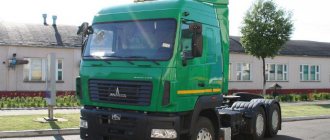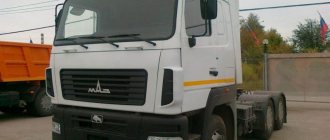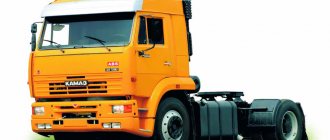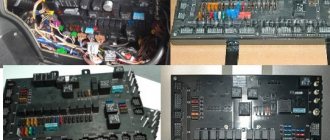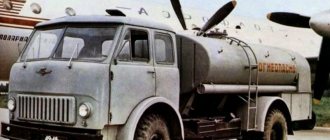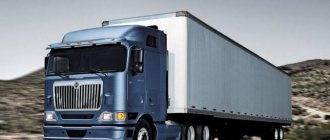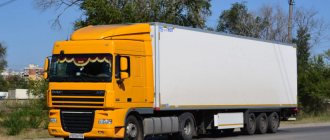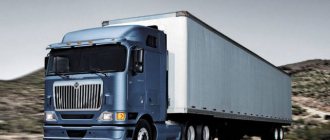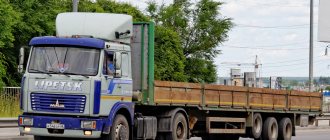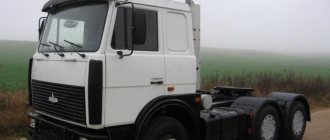Freight transport, such as the MAZ 54323, is the backbone of any economy. The production of truck tractors at the Belarusian Heavy Engineering Plant started at the very beginning of the fifties. Over sixty-five years, significant developments have been made, dozens of models have been created.
Model history
The first serial truck tractor of the MAZ-5432 series was assembled on the main assembly line of the Minsk Automobile Plant on May 19, 1981. This day is considered to be the starting point in the history of Belarusian third-generation long-haul trucks. The carrying capacity of this tractor reached 21 tons, and the total weight was 34 tons. In addition, this family was distinguished by a qualitatively new type of cabin with a double berth of large volume, more modern equipment and the presence of a transverse stabilizer in the front suspension design.
Truck tractor "MAZ-5432".
Launched into serial production in 1985, the MAZ-54322, with the YaMZ-238F2 diesel engine, and in 1988, the MAZ-54323, with the YaMZ-238B engine, were distinguished by an even more comfortable cabin and a modified design of the front part. Specialists took part in the development of the MAZ-54323 model. In particular, the cabin was equipped using technological solutions from MAN cabins of the F-2000 series. And in the same 1988, MAN’s 360-horsepower diesel engines were first supplied to MAZ (in the MAZ-54326 modification).
And this is the MAZ-54323 - with another modification of the YaMZ-238 engine and a redesigned cabin.
In 2000, these trucks, which by that time were among the leaders in production volume, had drive axles equipped with cross-axle differential locks, and the new front axle began to withstand a load of up to seven tons, and provide a steering angle of up to 45 degrees. .
Production of the MAZ-54323 and other 5432 series trucks was finally completed by 2008, when they were replaced by newer and more modern MAZ-5440. Do not confuse two- and three-axle Minsk mainline tractors: they have three axles.
PURPOSE
MAZ 5336 was conceived as a flatbed truck designed to transport various types of cargo independently or as part of a road train. The model was supposed to be used on interregional, intercity roads and inside populated areas. However, the design of the vehicle turned out to be so successful that soon various equipment began to be mounted on it, and the scope of application of the MAZ 5336 expanded significantly. The line includes tank trucks, construction versions and manipulators. Special emergency vehicles, passenger buses and fire brigades based on the MAZ 5336 also appeared. The series has become truly universal, but the main area of use remains the transportation of goods over medium and long distances.
Engine "MAZ-54323"
Truck tractors of this brand are equipped with the Yaroslavl diesel engine “YaMZ-238B”. This is an 8-cylinder liquid-cooled diesel engine, turbocharged and V-o6p (90°) cylinder arrangement. The technical parameters of this power unit are as follows:
- Working volume – 14.866 cubic centimeters;
- Power - 220 kW (300 hp), at 2000 rpm;
- Torque - 1177 Nm (120 kgf-m) at 1200-1400 rpm;
- Minimum idle speed – 600±50 min-1;
- Compression ratio – 15.2;
- The operating order of the cylinders is 1-5-4-2-6-3-7-8;
- Average piston speed – 9.33 m/s;
- Cylinder diameter – 130 mm, piston stroke – 140 mm;
- The weight of the engine without lubrication without gearbox is 1130 kg;
- Minimum specific fuel consumption – 208 g/kW h (153 g/hp h);
- Average effective pressure – 890.4 kPa (9.08 kgf/cm2);
- The engine service life before the first major overhaul is at least 10,000 hours.
The engine cylinder block is cast, made of low-alloy cast iron, cast as one piece with the upper part of the crankcase. The cylinder liners are of the “wet” type, made of alloy cast iron, with a water joint seal provided by three rubber rings. 2 cylinder heads - cast, made of low-alloy cast iron, one for each row of cylinders, with pressed seats and valve guides. The combustion chamber is single-cavity in the piston. Pistons are cast, made of high-silicon aluminum alloy.
The injection pump of this engine is 8-section, spool-type, with a low-pressure fuel priming pump, a fuel injection advance clutch and an all-mode speed controller. The air filter is dry, with a replaceable filter element and a clogging indicator. The YaMZ-238B engine is equipped with an electric torch device (EFD) to facilitate starting in cold weather. On the frame, this power unit is mounted on three supports: 1 front (bracket on the distribution gear cover) and 2 rear (located on both sides of the flywheel housing).
Technologically, the YaMZ-238B engine is similar to the YaMZ-238M2, and differs from it in the presence of a turbocharging system and associated design changes. The YaMZ-238B engine was originally developed specifically for MAZ road trains. It was also used as part of tractor equipment, front loaders and track machines, on dump trucks and bulldozers. Currently, this engine model is also no longer available.
Transmission
The YaMZ-238B engine is coupled with a YaMZ-238K double-disc clutch, also produced by the Yaroslavl Motor Plant, with a mechanical drive, peripheral coil springs and a pneumatic booster. Driven disks are equipped with a damper device. The outer diameter of the driven disk is 400 mm. It is possible to install a YaMZ-161 single-disk clutch, the outer diameter of the driven disk is 420 mm.
The eight-speed manual transmission of the MAZ-543205 brand is characterized by the presence of a range multiplier and is equipped with two reverse speeds. Synchronizers are available in all gears except reverse. The gear ratios are as follows: I-7.73; II-5.52; III-3.94; IV-2.80; V-1.96; Vl-1.39; VII-1.0; VIII-0.71; ZX-11.78 and 2.99. Speed shifting is carried out through a telescopic drive built into the gearbox.
The cardan transmission consists of one cardan shaft. The main gear is spaced, two-stage: a central bevel gearbox and planetary gears in the wheel hubs; the overall gear ratio is 5.49.
Suspension and chassis "MAZ-54323"
The front suspension of the truck is mounted on longitudinal semi-elliptical springs with shock absorbers and anti-roll bar, the rear ends of the springs are sliding. The rear suspension is on two main and two additional springs and a stabilizer bar, the ends of the additional springs and the rear ends of the main ones are sliding.
The wheels on the MAZ-54323 are discless, with 8.5V-20 rims, fastened with bolts with clamps. Tires – 11.00R20 (300R508), model “I-111A”. Air pressure in the front tires is 7.5, rear - 6.7 kgf/cm2.
Cooperation with MAN
The successful MAZ 54323 model is directly related to the plant’s 3rd generation heavy trucks; the first vehicle was assembled in the early 80s. The unit differs from earlier versions in a more comfortable cabin. There is a stabilizer bar in the front suspension area.
Eight years later there were several types of power plants. A few years later, the engines of the Yaroslavl plant that were previously installed (YaMZ-8421 and YaMZ-8424) were replaced with engines from the German concern MAN with a power of 365 hp.
The cooperation between MAZ and MAN has been going on for twenty years (since 1998). A joint venture was created, which began to produce truck tractors. The partnership made it possible to reduce production costs by a third, which had a favorable effect on the competitive abilities of the machines.
Steering and brake control
The design of the steering mechanism is as follows - a screw and a ball nut-rack, which is in clear engagement with the gear sector, and with the built-in power steering distributor. Gear ratio – 23.55. Power steering - with remote hydraulic cylinder.
The service brake system is of a drum type, with mechanisms with a diameter of 420 mm and a lining width of 160 mm. The MAZ-54323 brake system is equipped with a dual-circuit pneumatic drive, and the rear brake chambers are equipped with spring energy accumulators. The parking brake is carried out on the brakes of the rear wheels from spring energy accumulators, the drive of which is pneumatic.
The spare brake system is combined with the parking system. A pneumatically controlled motor retarder is used as an auxiliary brake. The semi-trailer brake drive is combined (two- and single-wire). There is a special fuse against condensate freezing.
Technical specifications in numbers
- Length of the tractor – 5,980 m, Width – 2,500 m, Height – 3,650 m;
- Wheelbase – 3,550 m;
- Turning radius on the outer wheel – 8.3 m;
- Turning diameter – 9 meters;
- Curb weight of the vehicle – 7.05 tons;
- Gross vehicle weight – 16 tons;
- Gross trailer weight – 26.8 tons;
- The total weight of the road train is 34 tons;
- Front axle load – 7 tons; on the rear axle (trolley) – 10 tons;
- Fifth wheel load - 8.8 tons;
- Fuel tank volume – 500 liters;
- The braking distance of a road train from 60 km/h is 36.7 m;
- The control diesel fuel consumption of the road train is 32.3 liters at 60 km/h, 41.8 liters at 80 km/h.
Weight of components and assemblies
- YaMZ engine without gearbox and clutch – 1150 kg, with clutch and gearbox – 1600 kg;
- Front axle – 443 kg, rear axle – 694 kg;
- Frame – 650 kg;
- Cabin – 645 kg.
The fifth wheel coupling device “MAZ-54323” is semi-automatic, with two degrees of freedom.
Cabin "MAZ-54323"
"MAZ-54323" is equipped with a double cabin with two berths. It is made with springs, tilting forward at an angle of 60 degrees, using a hydraulic cylinder. The driver's seat is sprung, adjustable for the driver's weight, length, height, cushion and backrest angle. There is a ventilation hatch in the cabin roof. The cabin ceiling is quite high, especially compared to previous MAZ trucks. A special fairing was often installed on top of the cabin to improve aerodynamic properties.
Device
All versions of the cars are built on a frame chassis with a wheelbase of 3550 mm. The front axle suspension is equipped with leaf springs and shock absorbers. Later, a torsion stabilizer was introduced into the design. The rear axle is mounted on leaf springs or air springs. Some trucks are equipped with a locking differential. All modifications have a rear stabilizer bar.
The engine is located in the front of the machine, covered on top by a folding cabin. The tractors used 1 and 2-disc dry clutches. Only manual transmissions with 5 to 16 speeds were installed. The rear axle is equipped with a conical main pair and additional planetary gears in the hubs. Between the bridge and the box there is a cardan shaft.
The brake mechanisms are equipped with a pneumatic drive; there are models with an ABS system. The electrical wiring diagram of cars is built according to a 1-wire circuit, the operating voltage is 24 V. The current sources are batteries and a generator installed on the engine.
Main Dimensions
- Length – 5950-5980 mm, 6065 mm (MAZ-MAN);
- Width – 2500 mm;
- Height – 3160 mm, 3116 mm (MAZ-MAN);
- Ground clearance – 280 mm;
- Wheelbase – 3550 mm.
Weight parameters
- Curb weight of the vehicle – 7050 kg;
- Load distribution – front axle 4680 kg, rear axle 2370 kg;
- Gross vehicle weight – 16000 kg;
- Load distribution at full weight – front axle 6000 kg, rear axle 10000 kg;
- Permissible weight per fifth wheel coupling device – 8800 kg;
- The total weight of the main semi-trailer is 26800 kg;
- The total weight of the road train is 34,000 kg.
Dynamic characteristics
- The maximum speed of the road train is 100 km/h;
- The acceleration time of the road train to 60 km/h is 60 s;
- Road train run-out from 50 km/h – 950 m;
- The braking distance of a road train from 60 km/h is 36.7 m;
- Control fuel consumption of the road train - at 60 km/h 32.3 l, at 80 km/h 41.8 l;
- Turning radius – on the outer wheel 8.3 m, overall 9.0 m.
Cabin
"MAZ-54323" is equipped with a double cabin with two berths. It is made with springs, tilting forward at an angle of 60 degrees, using a hydraulic cylinder. The driver's seat is sprung, adjustable for the driver's weight, length, height, cushion and backrest angle. There is a ventilation hatch in the cabin roof. The cabin ceiling is quite high, especially compared to previous MAZ trucks. A special fairing was often installed on top of the cabin to improve aerodynamic properties.
Reviews from owners and drivers of MAZ-54323
The cabin of this truck deserves a lot of positive feedback in terms of its spaciousness and ease of use. However, its susceptibility to corrosion is noted: the quality of the metal is unimportant. There are a number of people who are dissatisfied with the operation of the cabin heater. In severe frosts, it is not enough to create a comfortable atmosphere in the cabin. Therefore, some owners and drivers are engaged in additional insulation of the MAZ-54323 cabin (pasting with thermal insulation, additional oil heater). The cab bumper consists of three parts; its outer parts do not have the necessary strength.
High praise is given to the YaMZ-238DE engine: quite powerful, reliable, trouble-free, and generally one of the most durable diesel engines for trucks in history. But the standard gearbox is characterized as “too delicate”, and they even advise replacing it with a KamAZ one or “from a European”. They also criticize a weak and short-lived compressor and an insufficiently powerful generator (in winter, the batteries may not receive a normal charge). There is also a weakness in the crosspieces, which can be “treated” by replacing them with KrAZ ones.
Naturally, everyone notes the competitive price of this truck tractor: for that kind of money, a foreign car of this class can only be purchased in a very “shabby” condition. The machine is unpretentious to the quality of diesel fuel, spare parts for it can be found anywhere, and repairs, for the most part, can be carried out on your own, “in the field” and “on your knees”. The car is also not critical to oil. The brakes work very well.
In general, the MAZ-54323 is characterized as an inexpensive truck in terms of price and further maintenance and repair; quite reliable, unpretentious and hardy. The owners use this car as part of a road train. In terms of production and sales volumes, this model is among the long-term leaders in the product line of the Minsk Automobile Plant.
Peculiarities
The MAZ-54323 car is equipped with two types of signals:
- The pneumatic horn is located on the roof of the cab and is controlled by a button on the switch on the right under the steering wheel. Once the electric valve is activated, compressed air is released into the signal, causing the high and low frequency horn to produce a loud sound.
- Electrical alarms consist of high and low pitch sounds. It is activated via a knob on the steering column controller.
The alarm system also includes a noise relay, which reports a decrease in pressure and clogging of the oil and air filters. All the nuances of the device can be seen in the installation diagram of the air signal and its electrical backup.
It is worth noting that the electrical circuit of the MAZ-54323 for all modifications is standard, 254 volts. The complete structure of a truck tractor can be studied in the operation and repair manual.
Price of a used MAZ-54323 on the secondary car market
The new MAZ-54323 truck tractor cannot be found: in the 2010s, this model was replaced in the price list of the Minsk Automobile Plant by more modern similar vehicles. But the secondary car market is replete with offers for the sale of cars of this brand. This is not surprising, given its popularity in Russia and the CIS. Cars from the late 80s/early 90s are offered for 160-300 thousand rubles; for MAZ cars from the mid and late 90s - 350-450 thousand. From half a million to 650 thousand rubles will be asked for a MAZ-54323 manufactured in the early 2000s.
Flaws
MAZ 5336 has a reputation as a very reliable car. However, the model is not without drawbacks. The main disadvantage of the series is considered to be high fuel consumption. The problem is especially obvious on older versions.
The MAZ 5336 cabin provides a minimum of comfort by modern standards. The car is unpretentious and can withstand enormous loads, but the ease of operation is not very good, which is immediately felt during long trips. The problem is partly solved by correct adjustment of the chair.
Versions from the late 1990s often have defects in individual elements. Similar problems in later modifications are the exception.
